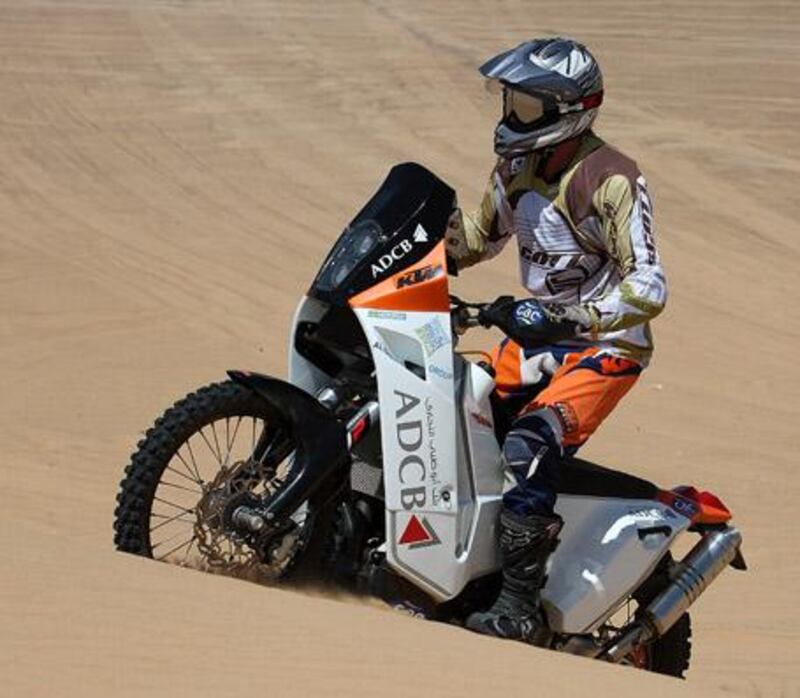Imagine, if you will, that Lewis Hamilton, just days before a Grand Prix, decided to toss you the keys (metaphorically speaking) of his McLaren Formula One car and say, "Take it for a spin". Oh, no pressure, just have fun. But if you bin it, not only would you have to mortgage your home to fix it, but the former world champion would also be out of a ride for the race and very, very angry with you.
So perhaps you can get an idea of how I felt when I was offered a jaunt on KTM's 690 Rally enduro bike, the same ride two KTM teams will be using in this week's Abu Dhabi Desert Challenge. I use the comparison with F1 because, in the world of off-road endurance rallying, there is arguably no better performing or more advanced bike than the KTM 690 Rally. It's the same one professionals like Marc Coma use to win the Dakar Rally and other events across the world.
Coma, possibly the world's foremost endurance rider, will be here competing with the KTM factory team. But a local team, ADCB KTM UAE, sponsored by the Al Shafar Group and made up of riders from right here in the Emirates, will also be in the running, and on the very same professional Rally bikes as Coma. It is on one of these motors that I'm taking a few rounds of dirt and dunes just south of Dubai.
"KTM recognises that we're an important market here. But they've also recognised our commitment to the brand and our racing talent, so they've thrown their support behind us," says Tim Trenker, the managing partner of the KTM distributor in Dubai and one of the riders on the local team. Trenker, originally from Germany, will be joined by James West of the UK, who is out with us today, Mark Ackermann from South Africa and Mohammed al Shamsi, an Emirati who will be riding a pro KTM 450 quad bike.
The Rally is based on a regular KTM 690 Enduro bike, but is extensively modified. Along with extra fuel tanks, an additional water tank (mandatory for the Challenge) and a competition exhaust system, engine power has been increased from 62hp to around 70hp, with 69.5Nm of torque, about five more than the normal bike. Of course, there is the addition of the front fairing and supports for the navigation equipment. As well, a select few Rallys, like the one I'm riding, are fitted with upgraded suspension for professional riders.
Each year, KTM builds just 50 of these bikes; the base Rally costs Dh135,000, while the optional suspension adds about Dh70,000. With the Desert Challenge just days away, these facts weigh heavily on me as I climb aboard. The last thing I want to do is ditch it at speed and bend the bars or crack the fuel tanks. Oh, and I guess I'll try not to hurt myself, too. "The torque is massive; it can cause you trouble. When you get the bike sideways, that's it," says Trenker. Hmmm, another thing to think about."But can also help you out when you're in trouble."
West finished third overall in the Challenge in 2008, a notable feat. He gives a demonstration of the bike before my ride and offers some insight on riding the 690 Rally. "It's much heavier than a motocross. The difference in riding is you have to be much more pinpoint with your control." More for my mind to worry about. At about 162kg dry, the Rally is some 50kg heavier than the 450cc motocross bikes on which I've gained my limited desert riding experience. I start it up, then gingerly roll the throttle on and take off down a small dune; the fact that I have no idea what to expect makes my mouth dry.
If you're looking for a full-on test of the 690 Rally, then I'm afraid you'll be disappointed. I didn't - couldn't - approach the limits of the bike, not like Trenker or West do. What I did find is that, surprisingly, it's not that difficult to ride. The torque is massive, but if you keep it in check you'll be fine. But when it helps is hitting the dunes, where it seems to have limitless power, no matter what gear it's in. It does mean more attention is needed when getting to the top, lest you keep on sailing into the air. The weight isn't an issue until you start to lose control; it makes it more difficult to bring it back. The main thing, like any bike, is to keep it stable and off its side.
I had that last part right until the end. With my ride over, I sailed up and over the top of a dune, landed perfectly and hit the brakes hard to stop where Trenker and West were waiting. I then promptly fell over. "Now, you have to pick it up," laughed Trenker. As I heaved the bike back to its wheels, I knew that the two will probably have to do it themselves at some point out in the sands of Liwa. But they'll do it with much more grace. nvorano@thenational.ae






